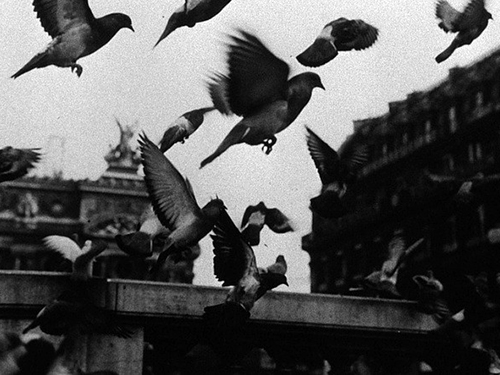
Time travel, still images, a past, present and future and the aftermath of World War III. The tale of a man, a slave, sent back and forth, in and out of time, to find a solution to the world's fate. To replenish its decreasing stocks of food, medicine and energies, and in doing so, resulting in a perpetual memory of a lone female, life, death and past events that are recreated on an airports jetée.
“This is the story of a man marked by an image from his childhood.”
opening of La jetée
“Can this film possibly substitute for the writing of a novel? To whom to attribute the continuous voice accompanying the images? By whom is this adventure told? A witness, the depersonalized essence of the hero? An experimenter? Or someone who has absolute knowledge of time, death, and the paradoxes of memory? The narrator or commentator (whoever is describing the whole experiment and its length, and who possesses knowledge of the hero’s soul–of the subject of the experiment), the one who speaks in the film, he is not its author, but the author of the novel that the film blows apart, sketches out, jettisons, cuts, and whose substance it reworks. That substance is the secret: the secret that animates the novel’s unending quest for that lost face and produces the petrified image that makes the character disappear behind the reality of an experimental subject, this nameless hero who can’t survive the conflict of images–who can’t, that is, write it down. He himself is an image, precisely the thing that the novel disperses or can never stabilize.”
Jean-Louis Schefer1

Chris Marker’s original workbook used for outlining La jetée.
- 1Jean-Louis Schefer, ‘On La jetée,’ www.chrismarker.org.[/fn]
“However, as each one of La Jetée’s static images lasts considerably longer than 1/24 of a second, on celluloid each still in La Jetée actually comprises dozens of replicas of itself. In presenting us with a series of frozen images, Marker dramatizes a breakdown of time’s invisible flow into a succession of visible moments that might be considered the individual atoms of time, and of our experience of time. Indeed, when the film’s hero journeys into the distant future, that new world is represented as a series of microscope images.”
Jonathan Romney
Jonathan Romney, ‘La Jetée: Unchained Melody,’ Criterion Collection, 2007.

